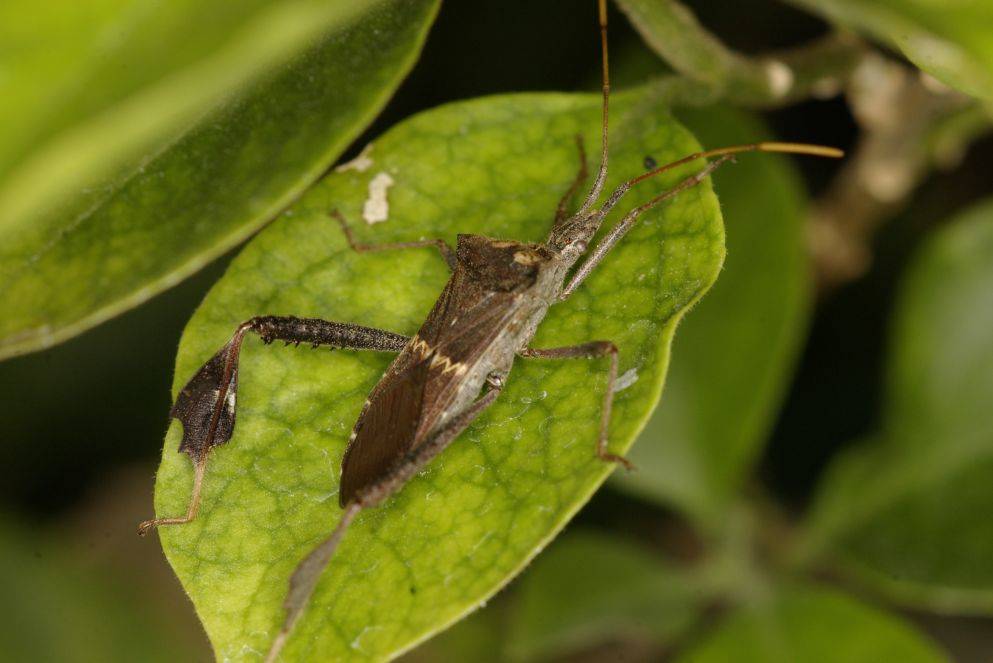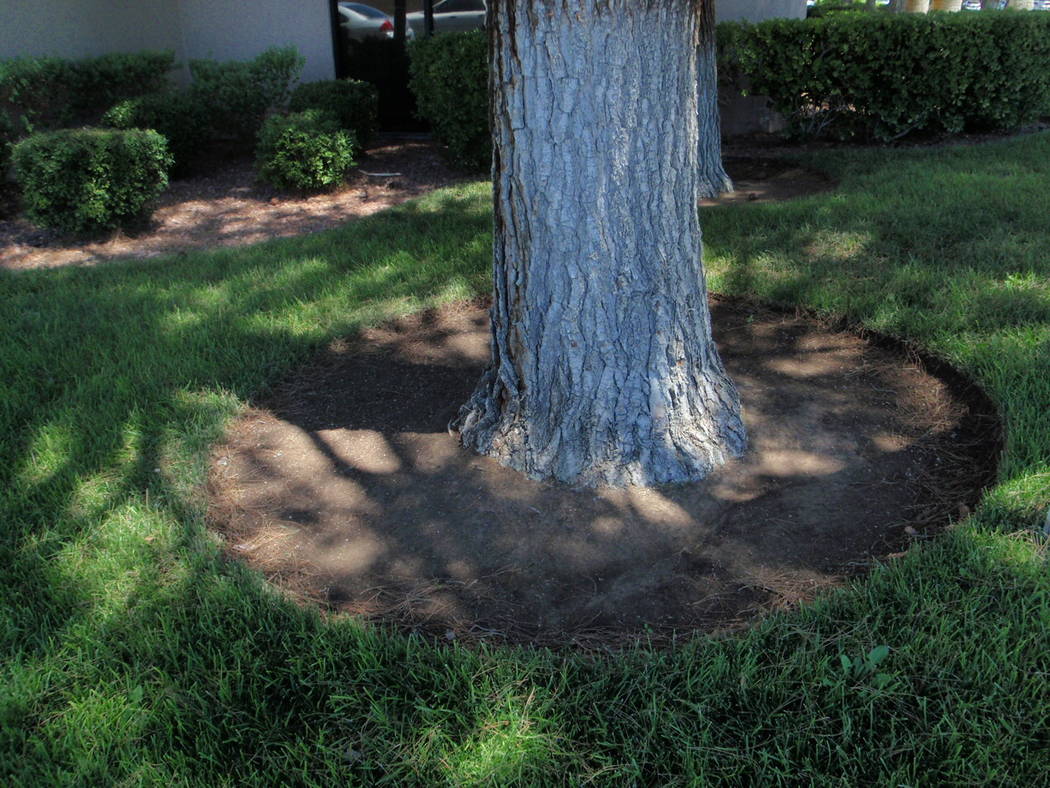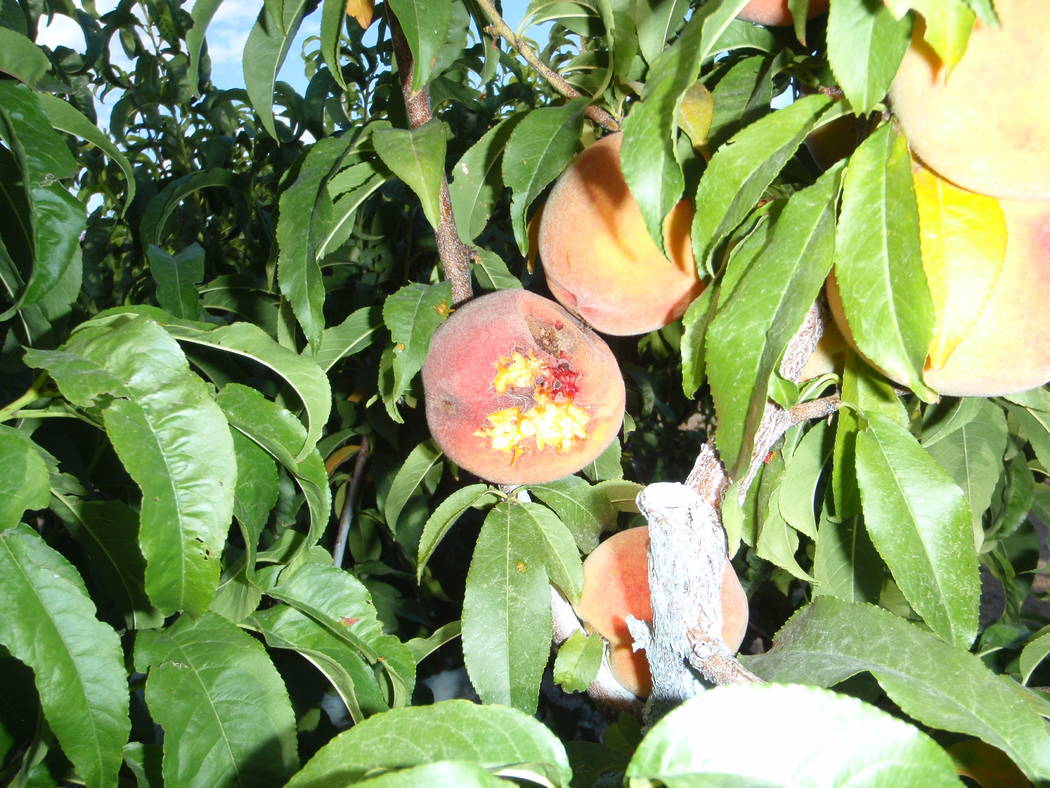Leaf-footed plant bug not easy to control
Q: I was reading up on controlling the leaf-footed plant bugs on my pistachio and almond trees and came across a recommendation by the University of California to use a pesticide containing bifenthrin. I see some Ortho products for lawn and garden contain bifenthrin. Is this a pyrethrin or something similar like you are recommending? Could this be used to spray the almond and pistachio every two to three weeks until it gets hot?
A: Good detective work. The leaf-footed plant bug is out now and very active. Yes, bifenthrin is a synthetic pyrethrin or pyrethroid. It is highly effective against leaf-footed plant bug, like most pyrethroids.
It is highly toxic to bees and fish, so always spray at dusk or when bees have gone home. Do not spray around koi ponds.
Protect yourself. It is moderately toxic to humans, but it is still a poison. Protect your face, because it enters the body most easily through moist tissue such as your nose, mouth and ears. Wear a long-sleeved shirt and disposable gloves.
Always follow the label on when to respray and when to stop spraying before harvest. Once the harvest has finished, you can spray again.
Unfortunately, this insect is not easily controlled, since it has wings, can fly and transfers to and from your neighbor’s plants. This insect probably is spending the winter as an adult on evergreens in your neighborhood, feeding on such plants as bottlebrush. Spray evergreen trees such as bottlebrush during the winter with a dormant oil to reduce their numbers before spring.
Q: I planted a 5-gallon Red Push pistache tree this past fall. I’ve been hand-watering it, and it’s doing great. I am landscaping the rest of my yard and installing an irrigation system. I ran a drip system with two 1-gallon-per-hour emitters to the tree. I am planting grass around the tree and wondering if this will be enough for it.
A: Water from a lawn surrounding the tree is usually enough for tree survival but not enough for best growth and establishment. It will struggle the first few years, because receiving only water from the lawn is minimal for its needs. The tree will grow and establish more quickly if the tree is watered separately from the lawn.
If you have selected 60 minutes as your watering time, you are giving this tree only 2 gallons of water. In my opinion, giving a 5-gallon tree only 2 gallons of water during each irrigation is not enough. I would replace these emitters with 3-gph emitters. When the tree doubles in size, add two more 3-gph emitters, totaling four emitters.
Keep grass 18 inches from the trunk while it is small. This helps prevent lawnmower-blight disease spread by lawnmower operators. As the tree gets older, increase this distance until the lawn is 2 to 3 feet from the trunk.
Trees and lawns struggle with each other, primarily for water and nutrients given to the lawn. Lawn fertilizers seldom make it to tree roots; trees should be fertilized separately from the lawn.
One technique used to fertilize trees and shrubs growing in lawns is called deep-root feeding. This technique places fertilizer for the tree below lawn roots but shallow enough so that tree roots can still get to it. Usually, this is about 12 inches deep.
Arborists and landscape companies offer deep-root fertilization, but you can do it yourself with a shovel and a bag of fertilizer. Videos on the internet offer guidance on deep-root feeding.
Q: I planted a Meyer lemon tree about three years ago on the southeast side of my house, where it would get sun in the morning, shade in the afternoon and some protection from wind. Every year, something eats all the leaves and blossoms, just absolutely stripping the plant of foliage. I fed it and wrapped it in netting, thinking it was birds destroying it, but every year I fail.
A: Bird damage to fruit and even vegetables is common. Grackles are a problem sometimes on green fruit, but they learn quite quickly that mature fruit is quite tasty and adapt. It is common to see grackle damage (beak holes) on ripe fruit such as peaches, apricots, plums and even apples, pears and tomatoes.
In northern states, it’s common to hear about damage, not only to fruit, but to fruit tree flowers as well. Bird pests can be cedar waxwings, cardinals, Baltimore orioles, grouse and quail. Flowers can be quite nutritious, and many are sweet to these birds because of the nectar. Ask any honeybee. In fact, plants are full of sugars, and the sugars are present in their sap, flowers and fruit.
But citrus flowers are new for me. I did some digging online to see if it’s been reported elsewhere, and there is not much information on the internet. I think we can make some assumptions, though.
Northern mockingbirds, grackles and quail have been reported to damage fruit and vegetables. We have all three here. I know quail can be a problem, and I’m sure many other people will agree. They can be cute, but they are also — like chickens — very pesky if left to roam on their own.
I see from your picture that you put bird netting over your small Meyer lemon. That’s a good start, but the bird netting cannot lay across the plant when the tree is small. It should be supported at least several inches above the plant canopy to protect the flowers and leaves. Make sure the bird netting is tacked tightly to the ground, or they will go under it.
Later, when the tree has some size to it, you can drape the netting over the tree and protect the flowers and leaves from damage.
Q: Some of our roses are loaded with buds on the same stem. Should I pinch one or two so the third one will be bigger?
A: You are referring to a technique called thinning. Thinning removes excessive numbers of flowers or fruit, so that the remaining flowers or fruit become larger. Make sure the buds you remove are flower buds and not leaf buds, and do it while they are small.
Thinning is done to many fruit trees and even some vegetables and flowers. Leaving only one fruit on a squash or pumpkin plant results in larger fruit. If you pick the right variety so it has enough potential, they can be huge.
Thinning doesn’t always result in larger flowers or fruit. Picking the wrong plant may not do anything to the flowers or fruit. For instance, you won’t see much difference after thinning figs, citrus or cherries.
If there are excessive numbers of flower buds, then the remaining ones will be larger with the possibility of better quality as well. Realize that flowers don’t get any larger than their potential. If the normal size of a flower is 2 inches in diameter and there are 50 of these on the plant, removing all of them except for one will not make the remaining one 20 inches in diameter.
There will be some increase in size or quality when some are removed. How many to remove and whether it’s worth it or not becomes a judgment call resulting from experience with specific plants or varieties.
Deadheading, or removing flowers after the flower has faded, can be an important practice that does conserve plant energy, improves aesthetics and can improve future flower production.
If you decide to remove some flower buds to see what happens, remove small ones and leave larger ones. Do it while buds are small. Otherwise, the plant spends energy making flower buds that are removed.
Bob Morris is a horticulture expert and professor emeritus for the University of Nevada, Las Vegas. Visit his blog at xtremehorticulture.blogspot.com. Send questions to Extremehort@aol.com.



















